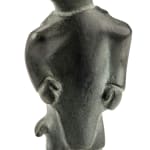-
Artworks
GEORGE TATANNIQ (1910-1991) QAMANI’TUAQ (BAKER LAKE)
Fox Woman, c. 1970-71stone, 6.5 x 3.25 x 2 in (16.5 x 8.2 x 5.1 cm)
signed, "ᑕᑕᓂ";
signed again, "TATANER".LOT 27
ESTIMATE $15,000 — $25,000
PRICE REALIZED: $19,200.00Further images
George Tatanniq was one of two Baker Lake artists chosen for Norman Zepp’s 1986 exhibition Pure Vision: The Keewatin Spirit. In our opinion, Zepp’s comment that “Tatanniq’s predilection for elegance...George Tatanniq was one of two Baker Lake artists chosen for Norman Zepp’s 1986 exhibition Pure Vision: The Keewatin Spirit. In our opinion, Zepp’s comment that “Tatanniq’s predilection for elegance and sophistication has resulted in a purity of line which elevates his sculpture beyond the purely descriptive” rings especially true for this exquisite small sculpture [1]. Tatanniq’s style is rooted in the Baker Lake sculptural aesthetic but distills it, emphasizing clarity of both line and form. Fox Woman is small enough to be cradled in one’s hands, yet it still manages to exude a powerful, even commanding sculptural presence. Two considerably larger versions of this subject are illustrated in Zepp’s catalogue; they are fine sculptures, but this Fox Woman conveys an intimacy and charm that is difficult to match on a larger scale.
This work depicts one the most poignant episodes in the famous Kiviuq story cycle, in which the (temporarily wifeless) hero Kiviuq discovers that his igloo has been tended and his meals cooked for him by a visiting female fox. In the story Kiviuq hides and watches the fox shed her skin to transform into a beautiful woman; he steals the skin and keeps it until she agrees to become his wife. Tatanniq has perhaps taken some artistic liberties; his depiction of the fox-human transformation is a relatively early example of what we now think of as “typical” transformations found in Baker Lake art. This story has been illustrated many times in a variety of media by several Baker Lake artists, most notably Victoria Mamnguqsualuk.
We doubt that the younger Baker Lake sculptor Josiah Nuilaalik was actually influenced by Tatanniq’s sculptural style; the two artists’ careers didn’t really overlap. But it certainly feels to us as if Tatanniq’s Fox Woman somehow prefigures Nuilaalik’s wonderful transformation subjects (see Lot 69). One of the most delightful features of Fox Woman can only be appreciated from the back: her lovely tail emerges out of her amautiq’s rear flap in a seamlessly “Nuilaalik” kind of way. Brilliant.
1. Zepp, Pure Vision, 1986, p. 48.
References: For a larger version of this subject by the artist from 1970 see Gerald McMaster ed., Inuit Modern: The Samuel and Esther Sarick Collection, (Toronto: Art Gallery of Ontario, 2010), p. 131; or Ingo Hessel, Inuit Art: An Introduction, (Vancouver: Douglas & McIntyre, 1998) p. 51. For another version see Darlene Wight, The Faye and Bert Settler Collection, (Winnipeg: Winnipeg Art Gallery, 2004), p. 92. Norman Zepp, Pure Vision: The Keewatin Spirit, (Regina: Norman Mackenzie Art Gallery, 1986) illustrates both works (cat. 70, 71). The Sarick version is particularly fine, but neither of the large versions exhibits the delicacy or intimacy of this small masterpiece.Provenance
Waddington’s Auctions, Toronto, Nov. 2002, Lot 96;
Sam Wagonfeld Collection, Denver;
His sale, Walker’s Auctions, Ottawa, May 2016, Lot 11.
Acquired from the above by John and Joyce Price, Seattle.Exhibitions
Loveland, CO, Loveland Museum / Gallery, Survival: Inuit Art, 2004.
Publications
Loveland Museum / Gallery, Survival: Inuit Art, (Loveland, CO: Loveland Museum / Gallery, 2004), reproduced p. 69;
Ken Mantel, et. al., Tuvaq: Inuit Art and the Modern World (Bristol, U.K.: Sansom & Co., 2010), fig. 164, reproduced p. 166.
Join our mailing list
* denotes required fields
We will process the personal data you have supplied in accordance with our privacy policy (available on request). You can unsubscribe or change your preferences at any time by clicking the link in our emails.








